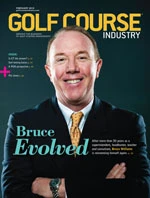In talking with superintendents, I’ve heard this scenario play out over and over again.
You attend an industry trade show, association meeting or an educational conference and become inspired by a new procedure, product or maintenance application that will surely save you time and money, and most importantly, it’ll improve course playability for your golfers.
You hit the turf and reproduce what you’ve learned down to a tee. You wait patiently for the results you’re sure will come and … fizzle, flop, failure. The results are less than spectacular and you’re ready to chuck everything out the proverbial window.
Does this sound familiar? Maybe too familiar? How often do you subscribe to a "one-and-done" philosophy to deal with failure or poor results, especially when adopting a new product, technique or method?
But this doesn’t have to be the case. In fact, researchers at Stanford University recently studied how scientists work, and have learned how they find success after several miserable failures. Here’s what they do:
• They ask questions from people outside their usual circle of colleagues;
• They’re open to ideas outside traditional thinking; and
• They learn from their failures.
The key to overcoming shortsightedness in the face of failure is to retrain your brain, which wants to blame outside factors for results that don’t correlate with the concepts we accept or – perhaps more importantly – have been taught to think and take as gospel. You need to accept failure as a signal that other factors need to be noted and examined.
I want to leave you with a technique that I’ve found to be helpful in troubleshooting failure – The 5 Whys. This technique was developed by Japanese inventor and industrialist Sakichi Toyoda and was used to develop the Toyota Production System. It’s a critical component of the automaker’s problem-solving training and hopefully was put into play to deal with a certain recent embarrassing recall. The process is simple: When faced with a problem you ask "Why?" five times and the nature of the problem, as well as its solution, become evident.
For example, let’s say your assistant is consistently late for your daily meeting.
Why? He is lazy. Because you never Why? There are merits to failure. When a reporter asked Thomas Edison about the thousands of experiments he conducted to develop the carbon filament, Edison famously responded: "I have not failed, not once. I’ve just found 10,000 ways that don’t work." I love that quote. Remember, failure doesn’t have to be a setback. If examined and processed the right way, failure can actually be a step forward.
disciplined him.
Why?

Explore the February 2010 Issue
Check out more from this issue and find your next story to read.
Latest from Golf Course Industry
- Editor’s notebook: Green Start Academy 2024
- USGA focuses on inclusion, sustainability in 2024
- Greens with Envy 65: Carolina on our mind
- Five Iron Golf expands into Minnesota
- Global sports group 54 invests in Turfgrass
- Hawaii's Mauna Kea Golf Course announces reopening
- Georgia GCSA honors superintendent of the year
- Reel Turf Techs: Alex Tessman





